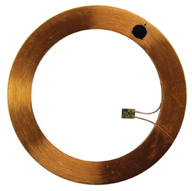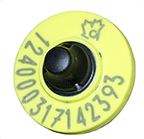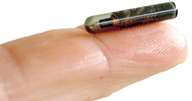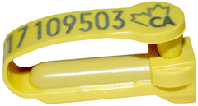| | A B C D E F G H I J K L M N O P Q R S T U V W X Y Z
A
Active tag: An RFID tag that has a transmitter to send information, rather than reflecting back a signal from the reader, as a passive tag does. Most active tags use a battery to transmit a signal to a reader. Active tags can be read from 300 feet (100 meters) or more, but they're expensive (typically more than US$20 each). They're used for tracking expensive items over long ranges. For instance, the U.S. military uses active tags to track containers of supplies arriving in ports.
Antenna: The transponder inside an RFID tag contains an antenna, usually a coil of copper wire, for sending and receiving data. Tag readers also have antennas which are used to emit radio waves. The RF energy from the reader antenna is "harvested" by the tag antenna and used to power up the microchip, which then sends back its own signal to the reader.
B
Bluetooth: Bluetooth is wireless technology for sending data over short distances. An electronic device with Bluetooth (BT) is “paired” with another BT device so they can communicate. For example, a hands-free head set for a cell phone works on Bluetooth. Using the same technology on the farm, a cordless RFID tag reader can send an ear tag number to a weigh scale so the animal’s number can be linked to its weight.
Electronic equipment is often marketed as “Bluetooth-capable” or “Bluetooth-enabled” These are not exactly the same thing. The term “capable” means that a device has the potential ability to connect by Bluetooth but it does not necessarily mean it’s ready and able right now. “Bluetooth-capable” usually means the device will accept an adapter, either internal or external, that will transform it into something that is “Bluetooth-enabled”.
Bluetoooth dongle: Equipment can be Bluetooth-enabled either built-in at the factory or afterwards by plugging a “BT dongle” as an adapter into a Bluetooth-capable device. Internal, built-in Bluetooth is always superior to an external dongle – the connection is much stronger and less prone to interference. Price is usually a good indicator of what you’re getting: Bluetooth-enabled cost more than Bluetooth-capable.
|  | |
| This is a Bluetooth dongle for a laptop. It will send an animal’s weight to another electronic device like a tag reader or a data recorder. |  | This is a Bluetooth dongle for a weigh scale. It will send an animal’s weight to another electronic device like a tag reader or a data recorder. |
D
Duplex: A tag reader sends a signal to the microchip in the tag, then "listens" for the EID number to be sent back. Duplex describes the channel that is transmitting data in both directions.
Tag technology divides tag/reader communication into Full Duplex (FDX) and Half Duplex (HDX). FDX allows the signal to go back and forth simultaneously. An example would be an ordinary telephone conversation where both parties can either speak or listen, or both, at the same time. HDX transmits in both directions but not simultaneously, similar to handheld radios where only one user at a time can "talk" while the other "listens".
Full duplex (FDX) is the most common system used in livestock identification. Half duplex (HDX) has a greater read range but is less common because of higher cost.
E
Electromagnetic interference: Interference caused when the radio waves of one device distort the waves of another. Cell phones, wireless computers, florescent lights and even robots in factories can produce radio waves that interfere with RFID tags.
Interference causes tags to fail to read. More common causes of interference are RF tag collisions - where multiple RFID tags are all energized by the same RF tag reader and try to send their signals at the same time. The reader cannot differentiate all the signals and becomes confused. Another is RF reader collisions - where multiple RF readers are all trying to read the same RFID tag so the electromagnetic field of one reader overlaps with that of another reader.
F
Factory programming: Some read-only tags must have their identification number written into the silicon microchip at the time the chip is made. The process of writing the number into the chip is called factory programming. This data can't be written over or changed.
Frequency: The number of repetitions of a complete wave within one second. 1 Hz equals one complete waveform in one second. 1KHz equals 1,000 waves in a second. RFID tags use low, high, ultra-high and microwave frequencies. Each frequency has advantages and disadvantages that make them more suitable for some applications than for others.
H
High-frequency (HF): From 3 MHz to 30 MHz
High-frequency tags typically operate at 13.56 MHz. They must be read from less than 3 feet away. HF tags transmit data faster than low-frequency tags but require more power than low-frequency tags.
I
Inductive coupling: Inductive coupling is the transfer of energy from one antenna coil to another by bringing them into close proximity. An RFID tag reader has a power source (battery or main power) that can energize the coil inside an RFID tag when the two devices are brought close enough together for the two coils to generate a magnetic field between them.
IP Rating: The IP stands for Ingress Protection. This is a rating given to electronic devices such as tag readers and handheld computers to indicate how dust- and water-proof they are.
The first digit indicates the level of protection against the ingress of solid foreign objects and the second digit against the harmful ingress of water.
IP6* - Fully Dust Proof
IP5* - Dust Protection (not entirely dust proof)
IP4* - 1mm protection (protected against objects over 1mm)
IP*7 - Immersion up to 1m in water (Work while holding underwater)
IP*6 - Powerful Water Jets from any direction (Spray down with pressure washer)
IP*5 - Water Jets from any direction (Wash down with low pressure hose)
IP*4 - Splashing Water
ISO: International Organization for Standardization; develops and publishes standards for technology, products and practices.
ISO 11784
The international standard defining frequencies, baud rate, bit coding and data structures of the transponders used for animal identification.
L
Low-frequency (LH): From 30 kHz to 300 kHz.
Low-frequency tags typical operate at 125 kHz or 134 kHz - mandated by the ISO as the frequency range for livestock identification around the world. Advantages of LF tags: least subject to interference; takes very little power to read a tag; easily read through living tissue; least expensive. The main disadvantages of low-frequency tags are they have to be read from within three feet and the rate of data transfer is slow. .
M
Memory: The amount of data that can be stored on the microchip in an RFID tag. It can range from 64 bits to 32 kilobytes or more on passive tags.
N
Noise: Unwanted ambient electrical signals or electromagnetic energy found in the operating environment of RFID equipment. Other RF devices, robots, electric motors and other machines can cause noise.
P
Passive tags: An RFID tag without its own power source and transmitter. When radio waves from the reader reach the chip's antenna, the energy is converted by the antenna into electricity that can power up the microchip in the tag. The tag is then able to send back information stored on the chip. Today, simple passive tags cost from 50 cents to several dollars, depending on the amount of memory on the tag, packaging and other features. Livestock RFID tags are passive tags.
Advantages of passive tags:
- Useful life of over 20 years.
- Small size - can be as small as a grain of rice.
- Cheap to manufacture
Disadvantages of passive tags:
- Short read range (less than two feet)
- Readable for years after the animal is no longer being tracked - chip must be destroyed to disable it.
Power level: The amount of RF energy radiated from a reader. The higher the power output, the longer the read range, but most governments regulate power levels to avoid interference with other devices.
R
Random access memory (RAM): Memory used for temporary storage of data. Information stored in RAM is lost when power is removed.
Read range: The maximum distance between a reader and a tag that still allows them to communicate. Active tags have a longer read range than passive tags because they use their own power source (usually a battery) to transmit signals to the reader. With passive tags, the read range is influenced by frequency, reader output power, antenna design, tag orientation and method of powering up the tag. Low-frequency tags use inductive coupling, which requires the tag to be within a few feet of the reader.
Read-only: A term used to describe RFID tags that contain data that cannot be changed unless the microchip is reprogrammed electronically.
Read-write: A term used to describe an RFID tag that can store new information on its microchip. These tags are often used on reusable containers and other assets. When the contents of the container are changed, new information is written to the tag.
Reader: A device used to communicate with RFID tags. The reader has one or more antennas, which emit radio waves and receive signals back from the tag. The reader is also sometimes called an interrogator because it "interrogates" the tag.
S
Shielding: Using a barrier to prevent RF noise from interfering with the ability to read RFID tags, or to prevent RFID readers from interfering with other RF devices.
T
Transponder A radio transmitter-receiver that is activated when it receives a predetermined signal. RFID transponders come in many forms, including smart labels, simple tags, smart cards and keychain fobs. RFID tags are sometimes referred to as transponders.
 |  |  |  |  |
| The transponder inside an RFID button tag - a coil of copper wire connected to a microchip. |  | The transponder inside an RFID loop tag - a coil of copper wire connected to a microchip, inside a glass capsule. |
U
Ultra-high frequency: From 300 MHz to 3 GHz.
Typically, RFID tags that operate between 866 MHz to 960 MHz. They can send information faster and farther than high- and low-frequency tags. But UHF radio waves don't pass through items with high water content, such as fruit or living tissue.
|
|